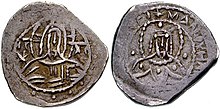Byzantine coinage

| Part of a series on |
| Numismatics the study of currency |
|---|
 |
Byzantine currency, money used in the Eastern Roman Empire after the fall of the West, consisted of mainly two types of coins: the gold solidus and a variety of clearly valued bronze coins.
Iconography

Early Byzantine coins continue the late Roman conventions: on the obverse the head of the Emperor, now full face rather than in profile, and on the reverse, usually a Christian symbol such as the cross, or a Victory or an angel (the two tending to merge into one another). The gold coins of Justinian II departed from these stable coventions by putting a bust of Christ on the obverse, and a half or full-length portrait of the Emperor on the reverse. These innovations incidentally had the effect of leading the Islamic Caliph Abd al-Malik, who had previously copied Byzantine styles but replacing Christian symbols with Islamic equivalents, finally to develop a distinctive Islamic style, with only lettering on both sides. This was then used on nearly all Islamic coinage until the modern period.
The type of Justinian II was revived after the end of Iconoclasm, and with variations remained the norm until the end of the Empire.
In the 10th century so-called "anonymous folles" were struck instead of the earlier coins depicting the emperor. The anonymous folles featured the bust of Jesus on the obverse and the inscription "XRISTUS/bASILEU/bASILE", which translates to "Christ, King of Kings"
Byzantine coins followed, and took to the furthest extreme, the tendency of precious metal coinage to get thinner and wider as time goes on. Late Byzantine gold coins become thin wafers that could be bent by hand.
The Byzantine coinage had a prestige that lasted until near the end of the Empire. European rulers, once they once again started issuing their own coins, tended to follow a simplified version of Byzantine patterns, with full face ruler portraits on the obverse.
Denominations
The start of what is viewed as Byzantine currency by numismatics began with the monetary reform of Anastasius in 498, who reformed the late Roman Empire coinage system which consisted of the gold solidus and the bronze nummi. The nummus was an extremely small bronze coin (about 8-10 mm), which was inconvenient because a large number of them were required even for small transactions.

The new bronze coins were made up of multiples of this coin such as the 40 nummi, 20 nummi, 10 nummi, and 5 nummi coins (other denominations were occasionally produced). The obverse (front) of these coins featured a highly stylized portrait of the emperor while the reverse (back) featured the value of the denomination represented according to the Greek numbering system (M=40,K=20,I=10,E=5). Silver coins were rarely produced.

The only (semi)regularly issued silver coin was the Miliaresion, minted in varying fineness with a weight generally between 7.5 and 8.5 grams. The Miliaresion was minted as early as the 6th century, but seems most common in the seventh through ninth centuries. Small transactions were conducted with bronze coinage throughout this period.
The golden solidus remained a standard of international commerce until the eleventh century, when it began to be debased under successive emperors beginning in the 1030s under the emperor Romanos Argyros (1028–1034). Until that time, the fineness of the gold remained consistent at about .955-.980.
In the early ninth century, a three-fourths-weight solidus was issued in parallel with a full-weight solidus, both preserving the standard of fineness, under a failed plan to force the market to accept the underweight coins at the value of the full weight coins. The three-fourths weight coin was called a Tetarteron (a Greek comparative adjective, literally "fourth-er"), and the full weight solidus was called the Histamenon. The tetarteron was unpopular and was only sporadically reissued during the tenth century. The full weight solidus was struct at 72 to the Roman pound, roughly 4.48 grams in weight. There were also solidi of weight reduced by one siliqua issued for trade with the Near East. These reduced solidi, with a star both on obverse and reverse, weighed about 4,25 g. Abd al-Malik reformed the Islamic Dinar in 693, and issued gold coins of 4,25 g weight.

By the time of the Emperor Romanos Diogenis (1067–1071) the solidus had been debased to only roughly 15% gold content. Under Alexius I Comnenus (1081–1118) the debased solidus was discontinued and a gold coinage of higher fineness (generally .900-.950) was established, commonly called the hyperpyron.

The hyperpyron was slightly smaller than the solidus. It remained in regular issue and circulation until the end of the Byzantine Empire in 1453, though after the second half of the fourteenth century it was also frequently debased. After 1400, Byzantine coinage became insignificant, as Italian money became the predominant circulating coinage. The Byzantine monetary system changed during the 7th century when the 40 nummi (also known as the follis), now significantly smaller, became the only bronze coin to be regularly issued. Although Justinian II (685–695 and 705–711) attempted a restoration of the follis size of Justinian I, the follis continued to slowly decrease in size.

Later scyphate (cup-shaped) coins known as trachy were issued in both electrum (debased gold) and billon (debased silver). The exact reason for such coins is not known, although it is usually theorized that they were shaped for easier stacking.
| Byzantine culture |
|---|
 |
See also

